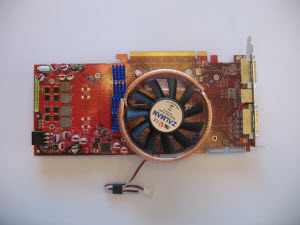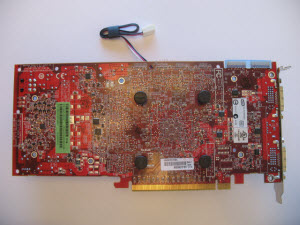Zalman 8700 & VF900 Quicky Review

The products in today’s quicky review are the Zalman CNPS8700 LED low-profile all copper CPU cooler and the Zalman VF900-Cu VGA cooler. Both heat sinks are radial-finned heatsink coolers made for the quiet computing enthusiast. Or in our case :), the HTPC enthusiast. Zalman has been well known around these parts because of their CNPS7000 series of CPU coolers; lets see if they continue their game with their current generation of coolers.
 |
|
| Zalman 8700 Low Profile Cooler | Zalman VF900-CU VGA Cooler |
The first obvious change you will see in the Zalman 8700 over the much older 7000 series is that this is a heat-pipe based cooler, this should increase cooling efficiency of the unit. You will find that the majority of heatsinks introduced onto the market are heatpipe based. Not just for looks, heatpipes are great way to transfer heat from the CPU to an array of fins.
The height of the 8700 is a scant 2.6 inches. This compact package makes it ideal for low profile situations such as HTPC cases :). Double check your dimensions prior to buying this cooler to ensure you have enough room. Head on over to Zalman’s product page to get full dimensional details.
The fan on the 8700 is 110mm dual bearing variety similar to other Zalman products. I think we would have all liked to see Zalman step outside the box on this one. While the fan is adequate and moves enough air, the noise character is typically very annoying and loud on anything but the lowest speed. The fan can be plugged directly into the motherboard or you can use the accompanied Fan Mate 2 to control fan speed.
Installation was fairly easy in my opinion, though not as easy as installing a stock heatsink. You have to attach a backplate to the underside of the motherboard. Not a good thing if you are retrofitting an old installation but easy enough on a new installation. On the Socket 775 motherboards, you insert a metal cross bar through the heatpipe to use as leverage to keep the heatsink in place. This little fiddly piece can be a pain in the butt to work with, I am sure there has to be a better way to make that work.
Test Bench/Performance
My test bench consisted of an Intel Core 2 Duo E7200, ASUS P5Q motherboard, S16V OrigenAE case and an AMD/ATI Radeon HD 4850 videocard. Testing was done to simulate a worst case scenario of load on the video card and CPU. Prime95 and 3D Mark were used this time around.
| Idle | Load | |
| Intel Stock Cooler | 45 | 58 |
| Zalman 8700 High | 48 | 55 |
| Zalman 8700 Low | 52 | 58 |
The Intel stock HSF, as always it seems, employs a rather loud fan that is by no means suitable for a quiet computing environment. This is the first change that should be made if you are building a quiet PC. However, it does keep the temperatures manageable. As you can see by the performance numbers, the Zalman does a pretty good job in keeping the temperature low. The difference in temperature between low and high (5 and 11 volts) was not significant enough to warrant keeping the fan speed above anything but the lowest setting.

|
 |
|
8700 – Polished copper base |
8700 – Radial fin design with 110 mm LED fan |
I was pretty disappointed with how the noise increased as soon as you moved passed 5 volts. It almost becomes unbearable at high and is no doubt louder then the Intel heatsink. However, at 5 volts the fan was almost inaudible. If you can keep it on low, which should be doable on most HTPC systems with decent airflow, you should have no problem with this HSF.
 |

|
|
8700 – Side view |
8700 – Fan Mate and mounting system |
Verdict: There are cheaper options that will do the same job.
We can see here that the HSF would probably work in a lot of systems, however, it is by no means the perfect HTPC cooler. What gets me is that it will cost you $60 to pick on of these coolers up. For that type of price, I would expect Zalman to put a little more effort into engineering a better fan/speed control system. Simply put, this is a pretty decent HSF put the price to noise to performance ratio leaves it out of the hands of a lot of DIY HTPC enthusiasts.
I have had the older VF700 installed on my HTPC systems for years. In my opinion, short of the ICeQ systems by HIS, Zalman’s VF series are one of the best after-market VGA coolers. The 8700 and VF900 are very similar in that they share a radial-fin heatpipe based copper cooler design. The VF900, of course, has been sized to fit the constraints of a video card.
 |
 |
|
VF900 – Installed on a Radeon HD 4850 |
VF900 – Back view of VF900 installed |
Installation was easier then the 8700, mostly because there is no fiddly metal cross bar to pin the cooler to the processor. The most important start to the process is to remove the stock HSF and cleaning up the reamaining thermal paste from the manufacturer. After getting that out of the way, you put the RAM heatsinks on. Apply the new thermal paste Zalman provides to the GPU core. Next you screw in the four "nipples" that are threaded to receive the screws from the back retention screws (which we’ll get to in a few seconds). Now slide the main heatsink unit into the four holes. After that, you turn over the card and screw on the four nuts with tension springs. It took around 10-15 minutes to get this process completed.
The VF900 uses an 80mm fan combined with the Fan Mate 2 to control its speed. At the lowest speed of 1350 RPM (5 volts), the fan is inaudible with the case open. I was very impressed. The noise/speed ratio is much more favourable in the VF900 as well. I was able to hear the first indications of fan noise at about 7-8 volts. Beyond that the fan noise ramped up as expected. At the highest speed there was noticeable fan noise from a few feet away. However, it wasn’t nearly as loud and aggressive as the 8700 was at full speed.
The test bench remained the same for this series of testing. We used the newest 3D Mark and Prime95 to keep temperatures as warm as possible.
| Idle | Load | |
| ATI Stock Cooler | 79 | 82 |
| Zalman VF900 High | 52 | 68 |
| Zalman VF900 Low | 56 | 83 |
The stock cooler uses a fan controller to automate its speed. This means you are not going to see a huge increase in temperature as the fan controller compensates for any rise in temperature you may see. ATI has tweaked their fan controller not to kick into high speed until it goes above 80 degrees. At idle, the stock fan is very quiet, however as the temperature starts to ramp up the fan becomes considerably louder and is not suitable for an HTPC environment.
On low speed, the VF900 significantly lowers the idle temperature and about matches the temperature of the stock cooler under load. As mentioned above, the fan is inaudible at this speed. At higher speeds, the VF900 cleans house in both the idle and load departments. The fan noise is about equal to the 4850’s fan speed under load. Neither of which I would want a few feet from my ears.
Verdict: It is a winner, there are very few after market VGA coolers that will match this type of performance.
As seen above, it blows away the stock cooler in cooling capabilities and it is much quieter to boot. Making it easy to install is just a bonus in my book.
Fan Mate 2
When using the Fan Mate on your Zalman coolers, I really do not recommend using the lowest or highest settings. I generally ease the fan speed up to the noise level I am comfortable with with and dial it back a notch.

Sapphire is a form of
Sapphire is a form of Aluminium Oxide known as Corundum. Pure Corundum
is in fact clear, and Pink Corundum, or
Pink Sapphire Rings,
is made up of Corundum (Al2O3), and traces of Titanium Oxide, which
account for the pink coloration.Sapphire is a powerful stone that can
take negative emotions and feelings and transform them into peace,
love and joy.